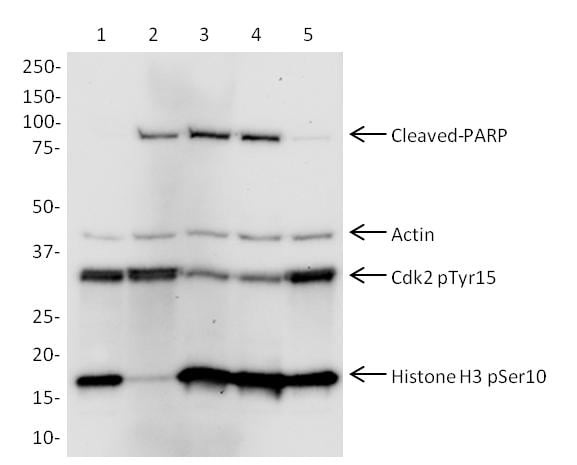Cell Cycle and Apoptosis WB Cocktail (pCdk/pHH3/Actin/PARP) (ab139417)
Overview
-
Product name
Cell Cycle and Apoptosis WB Cocktail (pCdk/pHH3/Actin/PARP) -
Species reactivity
Reacts with: Human -
Product overview
The Cell Cycle & apoptosis western blot cocktail (ab139417) is designed to provide a rapid assessment of cell cycle distribution and apoptosis induction based on molecular markers for the G1/S and M phases of the cell cycle and the presence of cleaved PARP. This is a mixture of four highly specific monoclonal primary antibodies targeting Cdk2 pTyr15, Histone H3 pSer10 , cleaved-PARP and Actin. Cyclin-dependent kinase 2 (Cdk2) is maintained in an inactive state in G1/S by inhibitory phosphorylation on Tyr15. Histone H3 is phosphorylated at Ser10 when chromosomes condense during mitosis. Hence, elevated Cdk2 pTyr15 indicates G1/S arrested cells and elevated Histone H3 pSer10 indicates M-phase arrested cells when compared to asynchronous cycling control cells. Poly [ADP-ribose] polymerase 1 (PARP) is a DNA repair enzyme that is cleaved by activated caspases, hence cleaved-PARP indicates induction of apoptosis. An anti- Actin antibody is included as a loading control. These four readouts are easily resolved by western blot given their different molecular weights. Because this western blot cocktail is a mix of rabbit and mouse monoclonal primary antibodies, a secondary antibody cocktail of HRP conjugated antibodies (anti-mouse and anti-rabbit) is provided.
-
Tested applications
Suitable for: WBmore details
Properties
-
Storage instructions
Store at -20°C. Please refer to protocols. -
Components 200 µl 2500X HRP Conjugated Secondary Antibody Cocktail 1 x 50µl 250X Cell Cycle & Apoptosis WB Cocktail 1 x 200µl -
Research areas
-
Alternative names
- ACTC
- ACTC1
- Actin alpha cardiac muscle 1
see all -
Database links
- Entrez Gene: 142 Human
- Entrez Gene: 1017 Human
- Entrez Gene: 70 Human
- Entrez Gene: 8290 Human
- Omim: 173870 Human
- Omim: 116953 Human
- Omim: 102540 Human
- Omim: 602820 Human
see all
Images
-
Paclitaxel induces dose-dependent G2/M-phase arrest and induces apoptosis (decreased Cdk2 pTyr15, increased Histone H3 pSer10, cleaved PARP present).
Primary antibody: All lanes Cell Cycle WB cocktail (MS1123) diluted to 1X in 4% milk/PBS.
Lane 1: HeLa lysate; Untreated, asynchronous cells
Lane 2: HeLa lysate; 2000 nM Paclitaxel, 24h
Lane 3: HeLa lysate; 100 nM Paclitaxel, 24h
Lane 4: HeLa lysate; 5 nM Paclitaxel, 24h
Lane 5: HeLa lysate; 0.25 nM Paclitaxel, 24h
All lysates at 15 µg per lane. Lysates are HeLa cells lysed in SDS lysis buffer.
Secondary antibody: All lanes are the WB secondary antibody HRP cocktail diluted to 1X in 4% milk/PBS. -
Hydroxyurea induces a G1/S-phase cell cycle arrest and induces apoptosis (increased Cdk2 pTyr15, decreased Histone H3 pSer10, cleaved PARP present). Paclitaxel induces dose-dependent G2/M-phase arrest and induces apoptosis (decreased Cdk2 pTyr15, increased Histone H3 pSer10, cleaved PARP present).
Primary antibody: All lanes Cell Cycle WB cocktail (ab139417) diluted to 1X in 4% milk/PBS.
Lane 1: Jurkat lysate; Untreated, asynchronous cells
Lane 2: Jurkat lysate; 5 mM Hydroxyurea, 24h
Lane 3: Jurkat lysate; 1000 nM Paclitaxel, 24h
Lane 4: Jurkat lysate; 50 nM Paclitaxel, 24h
Lane 5: Jurkat lysate; 2.5 nM Paclitaxel, 24h
All lysates at 12 µg per lane. Lysates are Jurkat cells lysed in SDS lysis buffer.
Secondary antibody: All lanes are the WB secondary antibody HRP cocktail diluted to 1X in 4% milk/PBS.
Predicted & observed band size: 89, 42, 33, 17 kDa.





